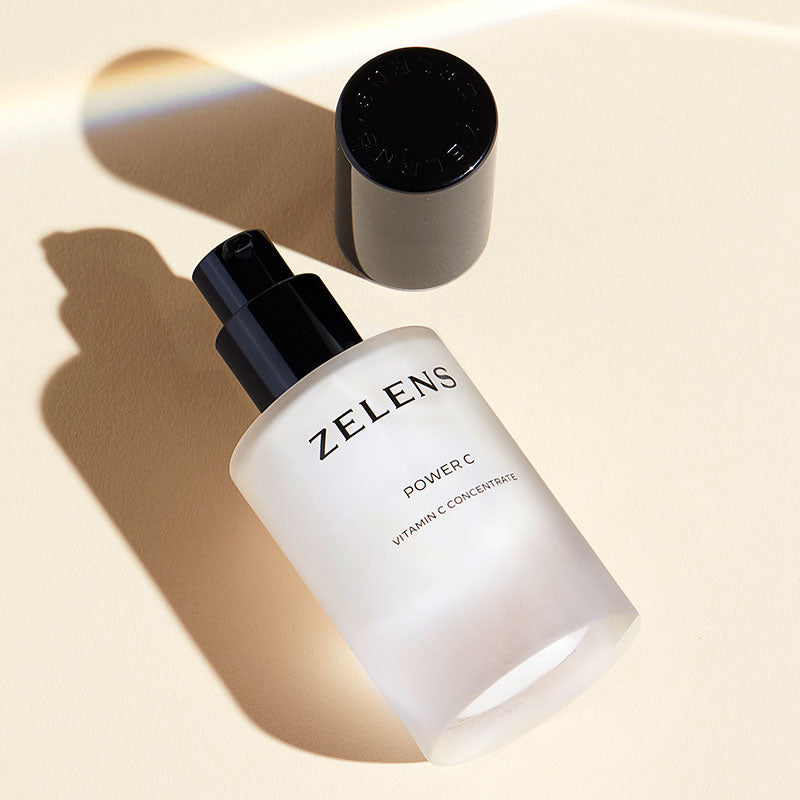Skin Science Glossary
In the descriptions of our formulas, scientific terms are sometimes used. In this glossary, Dr. Lens helps to explain some of these terms. You can use this list to look up some of the terms that you may encounter when studying our products and their ingredients.
Amino acids: Organic molecules composed of carbon, oxygen, hydrogen and nitrogen, along with a variable side chain group. Amino acids represent the building blocks of proteins. Proteins have different properties: they improve skin firmness and elasticity, reduce the appearance of wrinkles and enhance skin resilience.
Antagonist: A substance that blocks an action of a molecule or impede the normal function of a system.
Antioxidant: A substance (molecule) that fight free radicals and thus prevent the damage caused by free radicals. Antioxidants are often called “free-radical scavengers”.
Anti-allergic: A property of a molecule that helps to relieve, control or prevent allergic reaction.
Anti-inflammatory: A property of a molecule that helps reduce inflammation.
Antibacterial: A property of a molecule that destroys bacteria or blocks their growth.
Antimicrobial: A property of a molecule that destroys microorganisms (bacteria, vuruses, protozoans and fungi) or blocks their growth.
Astringent: A property of a molecule that causes the contractions or shrinkage of tissues (such as the skin) and which dries up secretions.
Bioactivity: Also knows as biological activity, it describes the beneficial or adverse effects of a substance on living tissue (such as the skin).
Biomimetic: Having functions that mimic biological processes, or having a structure that is similar to the structure found in natural environments (for example skin).
Cell metabolism: A set of chemical reactions that occur in living cells in order to maintain life.
Cell respiration: A set of metabolic reactions and processes that take place in the cells to convert chemical energy from oxygen molecules or nutrients into adenosine triphosphate (ATP), and then release waste products.
Ceramides: A family of lipid molecules composed of sphingosine and a fatty acid, naturally present in the cell membrane. Ceramides reinforce skin barrier function.
Chelating: Binding up trace metal ion contaminants in the water-containing cosmetic, thus keeping the product microbe free for longer.
Circadian rhythm: A natural, internal process that regulates the sleep–wake cycle and repeats roughly every 24 hours. The skin too is affected by the circadian rhythm.
Collagen: The major building block (protein) of the skin. It forms a scaffolding to provide strength and structure. Collagen production in the skin decreases as we age.
Corneodesmosomes: The main intercellular adhering structures in the stratum corneum - the outer layer of the skin (epidermis).
Elasticity: The ability of the skin to stretch and snap back to its original shape.
Emollient: A molecule that soothes and softens the skin.
Enzymes: Biological molecules that significantly accelerate all chemical reactions that take place within cells.
Esters: Chemical compounds derived from an acid (organic or inorganic) and an alcohol.
Extracellular matrix: A gel-like matrix composed of a variety of polysaccharides, water and collagen proteins that occupies the space between cell and cell. It gives the skin elasticity, tensile strength and resilience.
Fatty acids: Molecules that are long chains of lipid-carboxylic acid found in fats and oils and in cell membranes as a component of phospholipids and glycolipids.
Fermentation: A metabolic process that produces chemical changes in organic substrates (plants) through the action of enzymes. We use fermentation for many botanicals in our formulas, to maximise the benefits that we obtain from them.
Fibroblasts: Principal cells of the dermis (layer of the skin) involved in the production of collagen and the extracellular matrix.
Filtrate: A liquid that has been passed through a filter.
Flavonoids: A class of polyphenolic molecules found in plants. Shows antioxidant properties.
Free fatty acids: By-products produced by the hydrolysis of oils and fats.
Free radical: Any molecular species capable of independent existence that contains an unpaired electron in an atomic orbital. Free radicals attack important macromolecules leading to cell damage and homeostatic disruption.
Glycation: The spontaneous reaction of the attachment of a carbohydrate (sugar) to another biomolecule, such as a protein, lipid, or DNA. Glycation leads to premature skin ageing.
Glycolipids: Components of cellular membrane composed of a lipid tail and one or more sugar groups.
Guanine: One of the four main nucleobases found in the nucleic acids DNA and RNA.
Humectant: A substance that absorbs moisture from the air and increases the amount of water in the surface layers of the skin.
Hyaluronidase: An enzyme that speeds up the degradation of hyaluronic acid.
Ionosome: A tailor-made vector system that provides encapsulation of hydrophilic active ingredients. Resistant to surfactants and electrolytes.
Inflamm-ageing: Chronic low-grade inflammation, responsible for premature skin ageing.
Keratinocytes: The primary type of cell found in the epidermis, the outermost layer of the skin
Lysate: The solution consisting of the material released from cell lysis (cellular disruption).
Matrix metalloproteinases (MMPs): A family of enzymes responsible for the degradation of all kinds of extracellular matrix proteins, including collagen.
Microbiota/Microflora: A complex and dynamic set of microorganisms (bacteria, archaea, fungi and viruses) living on the skin.
Mitochrondria: Cell structures (organelles) that generate the chemical energy necessary to power the cells’ biochemical reactions.
Moiety: A part of a molecule that is given a name because it is identified as a part in other molecules as well.
Molecular weight: Also known as molecular mass, it is a mass of a given molecule, measured in daltons. Molecular weight impacts how easily certain skincare ingredients, such as hyaluronic acid, can penetrate the skin.
Niosomes: Lamellar structures composed of surfactants and cholesterol which entrap water-soluble active molecules, to protect them from the biological environment allowing better availability and controlled delivery.
NMF (Natural Moisturising Factors): A group of components naturally present in the skin's uppermost layers (stratum corneum) to maintain adequate skin hydration. Made up of multiple amino acids, fatty acids, triglycerides, urea, ceramides, phospholipids, glycerin, saccharides, sodium PCA, hyaluronic acid and many other components.
Nucleoside: The structural sub-unit of nucleic acids such as DNA and RNA, composed of a nucleobase and a five-carbon sugar.
Peptide: A short chain of between two and fifty amino-acids, linked by peptide bonds.
Photoprotective: Ability of a molecule to protect from the damage caused by sunlight.
Phosphatidylcholine: A class of phospholipids that include choline as a headgroup. They are a major component of the cell membrane.
Phospholipids: A class of lipids that are the main component of the cell membrane. Each phospholipid molecule contains a hydrophilic “head” containing a phosphate group and two hydrophobic “tails” derived from fatty acids, joined by a glycerol molecule.
Hydrophylic: The ability to mix well, dissolve, or to be attracted to water.
Hydrophobic: The opposite of hydrophylic: do not mix with water, or resistant to wetting with water.
Phytosterols/Plant sterols: A family of molecules related to cholesterol naturally present in plants.
Polyphenols: A large family of compounds naturally occurring in plants, composed of multiple phenol units. Polyphenols act as antioxidants that fight damaging free radicals.
Polymers: A class of natural or synthetic substances composed of very large molecules (macromolecules), which essentially are a combination of many subunits.
Polysaccharide: A large molecule made of many smaller monosaccharides (simple sugars, like glucose).
Prebiotics: Compounds in food that induce the growth or activity of beneficial microorganisms such as bacteria and fungi. Prebiotics in skincare support the growth of good (beneficial) bacteria on the skin surface to help rebalance healthy skin microflora, demonstrate excellent moisturising properties and promote healthier skin.
Probiotics: Live bacteria and yeasts that are intended to have health benefits when consumed or applied to the body.
Progerin: An abnormal protein, truncated version of lamin A protein. The synthesis (build up) of progerin in the skin interferes with normal cell functions and causes premature skin ageing.
Proteolytic: Ability of enzymes to break long chainlike molecules of proteins into peptides and eventually into amino acids.
Proteosomes: A very large protein complexes, known as multi-subunit enzyme complex, that degrades unneeded or damaged proteins by proteolysis (the breakdown of proteins into smaller polypeptides or amino acids).
Provitamin: A substance that may be converted within the body to a vitamin.
Ribose: A type of simple sugar, or carbohydrate, produced by our body. It is found in RNA.
RNA (Ribonucleic acid): A nucleic acid that is similar in structure to DNA. Messenger RNA transfers information from the genome into proteins by translation while transfer RNA carries camino acids to the translation site that allows them to be assembled into chains of proteins in the process of translation.
Saccharide: A term for sugar, derived from Latin.
Skin barrier: The outermost part of the epidermis (the stratum corneum).
Sphingolipids: A class of lipids composed of a sphingosine head (18-carbon amino-alcohol backbone) and a long-chain fatty acid chain. Sphingolipids are universal components of cell membranes and also important signaling molecules.
Stratum corneum: The outer layer of the skin (epidermis).
Telomeres: The specific segment of DNA found at both ends of each chromosome. Telomeres act as the ageing clock in every cell, controlling the cell’s lifespan.
Transepidermal water loss (TEWL): The amount of water that passively evaporates through skin to the external environment due to water vapor pressure gradient on both sides of the skin barrier.
Yeast: A single-cell fungi (Saccharomyces cerevisiae). Offers many benefits for the skin.

